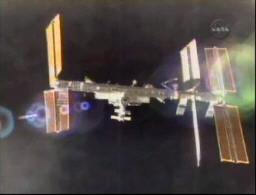The orbiting International Space Station (ISS) will become a fully operative research facility this week with the addition of an Italian-built laboratory .
The Columbus lab, the biggest single addition to the ISS, was developed by the European Space Agency (ESA) and built in Italy by Thales Alenia Space, formerly Alenia Space.
It will be delivered to the ISS in a shuttle mission set to blast off on Thursday from Cape Canaveral, in Florida.
''Columbus is the biggest laboratory that Europe has sent into space. With its addition the ISS will be almost completed and will be fully operational as a research facility,'' observed Giovanni Bignami, chairman of the Italian Space Agency (ASI).
Thales Alenia Space contributed the primary module for the Columbus lab which was based on the technology it developed for the Multi-Purpose Logistics Modules, or MPLMs, which were sent to the ISS in the last shuttle mission.
While the MPLMs are considered to be 'space moving vans', the Columbus module contains an entire suite of scientific laboratories in its 75 cubic meters of space. The Italian company also contributed two of the five internal payload racks for the Columbus, while Italy's Carlo Gavazzi Space built one of the two external racks.
The two internal racks were the Fluid Science laboratory (FSL) and the European Drawer Rack (EDR). The first will accommodate experiments on the behaviour of weightless liquids, the results of which could be applied on Earth in such areas as cleaning up oil spills and to improving the manufacture of optical lenses.
The EDR is a modular and flexible experiment carrier system for a broad number of scientific studies and provides basic accommodation and resources for experiment modules housed within standardised drawers and lockers.
The external European Technology Exposure Facility (EuTEF) will be used for experiments which require exposure to a space environment.
Each rack is about the size of a telephone booth and houses an independent laboratory with video and data links to researchers on the ground.
The Columbus lab will be connected to the ISS through the Italian-made Node 2, which was built by Thales Alenia Space on a ASI.
Node 2, also known as 'Harmony', was the primary payload of last fall's Esperia Mission which saw the participation of Paolo Nespoli, the third Italian astronaut to take part in an ISS mission after Umberto Guidoni in April 2000 and Roberto Vittori in 2002.
Node 2 was designed to be a connecting passageway not only for the European lab but also for the American Destiny and the Japanese Kibo laboratories.
It will also serve as an attachment point for the Japanese HII Transfer Vehicle, future MPLMs and for the Space Shuttle.













